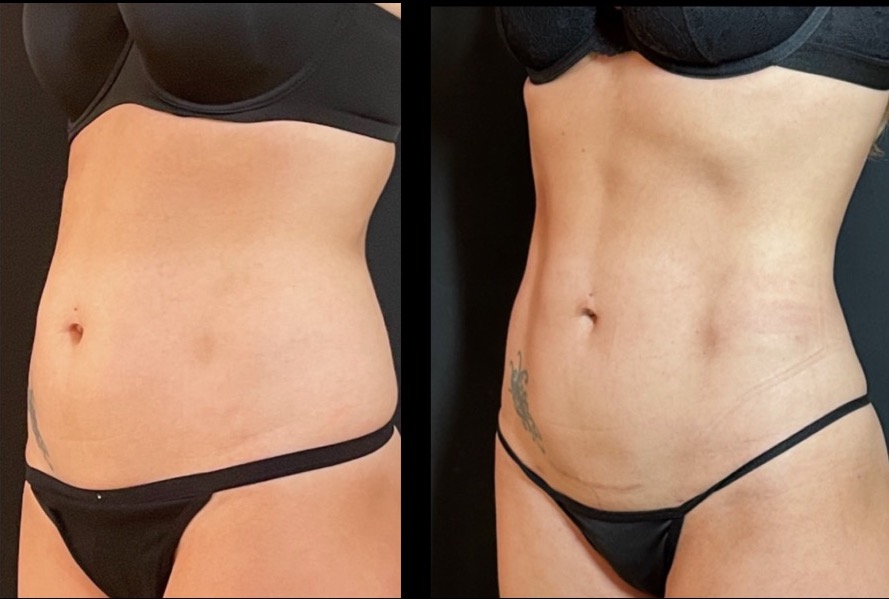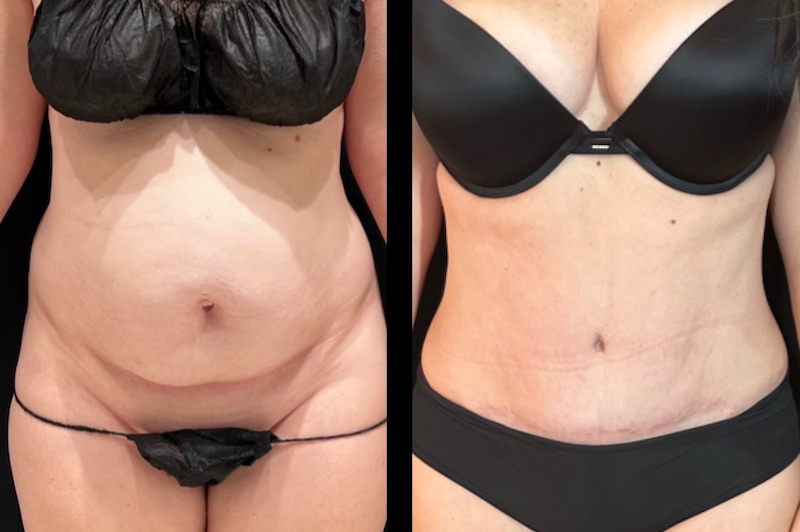It’s very common for patients to confuse, or question, the difference between liposuction and tummy tuck procedures. Both surgeries seemingly accomplish similar results—they sculpt a better body. However, though comparable, these two are not interchangeable.
Liposuction vs Tummy Tuck: The Basics
To sum it up: liposuction is best to target stubborn, unwanted fat that is resistant to diet and exercise with minimal to moderate loose skin. Tummy tucks address loose, stretched skin and separated muscles from pregnancy along with stubborn fat. Tummy tucks can be performed as a result of other conditions, such as dramatic weight loss, which we are now seeing with drugs like Ozempic, but the majority of patients that undergo the procedure have had children in the past.
How is a Liposuction Procedure Different Than a Tummy Tuck?
Both procedures are done to improve self-confidence but they dramatically differ in how they’re performed.
Liposuction uses a small, hollow tube (as the name suggests) to suction fat from various areas of the body that seem to be resistant to diet and/or exercise. The most common area it is performed is the hips, thighs, and belly; each incision is the size of a dime. It can be, though is not always, done under local anesthesia, meaning patients remain conscious while only a small area of the body is numbed.
Liposuction is done nine out of 10 times during a tummy tuck, but the procedure does differ. A tummy tuck procedure is exclusive to the abdomen area and targets the skin, the diastasis recti if present, and fat. The incision varies in length but the width is from hip to hip. One unique aspect of Neinstein Plastic Surgery is the surgical team’s ability to perform mini tummy tucks in unique, clinical scenarios—such as a mother who has a diastasis recti but no loose skin. This is usually done under general anesthesia, which requires patients to be completely unconscious.


While liposuction and tummy tucks are both cosmetic surgeries, a tummy tuck can oftentimes feel like a necessity if your abdominal muscles don’t function the same or you have excess, loose skin that seems to get in the way of everyday life.
Muscle repair, also known as diastasis recti, is very common to perform during a tummy tuck. As a result of considerable weight gain (or as a result of pregnancy), the muscles separate. Many individuals who stick to a consistent exercise routine may notice, over time, that the muscles in the abdomen return to as they were (or nearly). However, there are instances where the muscles do not rebound or retain the same elasticity as they once did, causing them to stay apart and bulge. A tummy tuck procedure addresses this key issue.
Check out these statistics! Liposuction is steadily raising as the number one most common surgical procedure in the U.S.—from nearly 271,000 in 2019 to over 491,000 in 2021. And tummy tuck procedures continue to gain in popularity, up to nearly 243,000 in 2021 from over 140,000 in 2019.
Is Recovery Time The Same?
As a less invasive procedure, liposuction has a shorter recovery time. Patients should expect to take off between three and five days from work, and skip any labor-intensive activity, or workouts, for two weeks. Patients will also need regular lymphatic drainage massages two days out, and remain in a compression garment for six weeks.
Tummy tucks are much more invasive, so the recovery time is two weeks. Due to the hip-to-hip incision, patients will feel hunched over at first and should sleep slightly elevated with a pillow under their knees so that the incision doesn’t tug or stretch. There is no gym or labor-intensive activity for one month and the lymphatic drainage massages begin one week out while remaining in a compression garment for six weeks.
Both liposuction and tummy tucks require post-op follow-ups one-week, one-month, three-month, and six-month to ensure that recovery is moving along smoothly.
Post-Op Support System
A support system can be invaluable in both surgical post-op recoveries, and at any age or stage in life. Dependent on the invasiveness of the procedure, you might require an escort to/from on the day or a private duty nurse. But more than the physical requirements, a support system ensures your mental well-being. Surgery of any kind, major or minor, elective or non, can have an emotional impact. It’s completely normal and expected, which is why it’s better to have friends or family to talk to, just in case.
Other Questions
Is it covered by insurance?
As both are elective procedures, insurance does not cover the costs. However, despite paying out of pocket, you’ll retain long-term benefits.
How can patients prepare for pre-op?
Immediately upon booking your chosen procedure, we will provide you with a Patient Tool Kit. This kit contains comprehensive literature with any of your pre-op questions. Pre-op will also require you to see your primary care physician (PCP) to have a full physical workup and lab tests within 30 days of your surgery.
We are here to answer any questions or concerns that arise to make you feel most comfortable as you decide whether liposuction or a tummy tuck is best for you. More than doctors, we are your support system from that initial consultation to the final follow-up meeting.
Schedule your consultation with us today by calling 212-249-0949 or completing our contact form.
